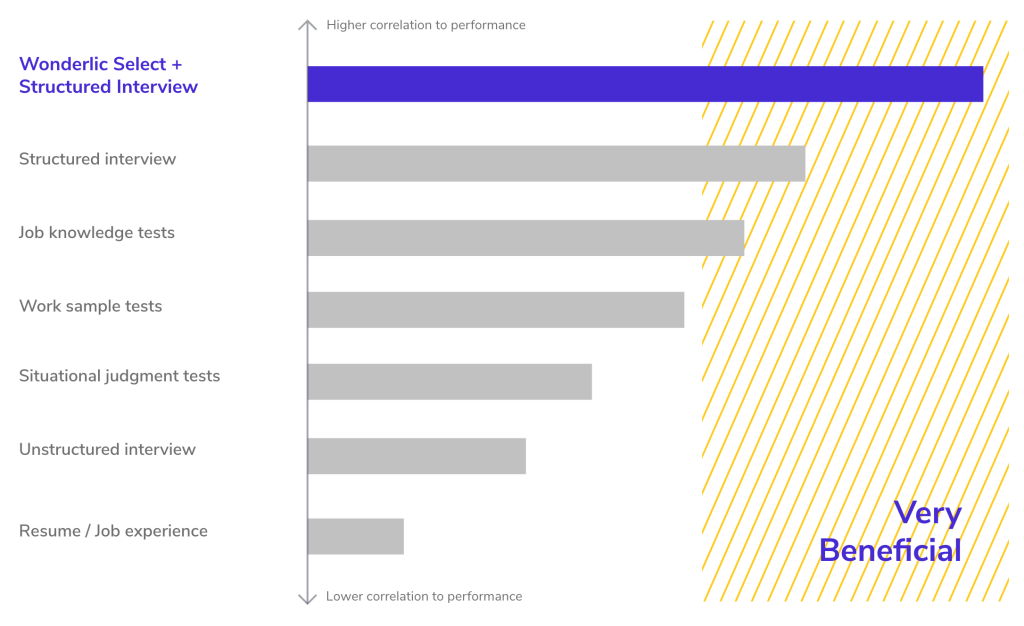As an HR professional, you know high staff turnover can wreak havoc on any company. Conducting a motivation assessment can help address this issue. Research shows the cost of replacing an employee averages 50% to 200% of their annual salary. Beyond monetary costs, there’s a big hit to productivity and company morale, especially if other workers have to assume that missing employee’s responsibilities temporarily. And let’s not overlook the potential loss of institutional knowledge and relationships with vendors and clients.
With the average voluntary turnover rate hovering around 17%, few businesses are immune.
While many organizations evaluate candidates for experience or skills, they often fail to assess one of the top predictors of retention: motivation.
A motivation assessment measures what candidates and employees want to do or are driven to do in the context of work.
Our research has shown that employees whose motivation levels are closely aligned with their jobs are half as likely to leave than those whose levels don’t align. What’s more, they’re 2.5 times more likely to be rated as top performers by their supervisors. These statistics alone make a compelling case for conducting motivation assessments.
In addition, understanding what motivates employees can help your company better train and develop those workers. This is especially important given that a lack of career development has long been a top catalyst for turnover.
In this blog post, we explore how employee motivation assessments can help you hire candidates who are not only capable of doing the job but also motivated to do it well and stay with your company. We’ll cover:
Table of contents
What is a motivation assessment?
A motivation assessment is a type of pre-employment test that gauges an individual’s motivation levels, surfacing their internal desires and affinities. For example, say you have an accountant candidate who tops the charts in terms of accounting skills and cognitive ability. However, they’re more motivated by creativity and artistic endeavors than routine and methodical tasks. Because the accountant position is more methodical than creative (for good reason! You don’t want your accountants getting overly creative with your numbers), this candidate is less likely to stay in the job and be fully engaged and productive while in that role.
While many might assume that a good salary, benefits, and work-life balance are prime motivators — and they are certainly important — those extrinsic motivators often come second to intrinsic factors. These encompass everything from efficiency and financial security to creativity and independence. These drivers are why some employees leave a high-paying position for one that pays less but is more fulfilling.
Motivation assessments aren’t used as frequently as other types of pre-hire assessments — but that doesn’t mean they’re any less valuable. While there are a few motivation assessments on the market, the most predictive ones use the RIASEC occupational model.
The 6 Categories of the Holland/ RIASEC Model
- Realistic/practical
- Investigative
- Artistic
- Supportive/Social
- Enterprising
- Conventional/traditional
Few people fall neatly into any one category. However, by understanding which characteristics are dominant within an individual and their interests, you can determine the types of work a candidate would inherently prefer and the intangible benefits that would most likely spur them to succeed. For instance, a person who scores high in supportive/social and artistic characteristics is more likely to thrive — and remain — in a setting that requires a great deal of interpersonal communication and ad-hoc problem-solving than they are in a highly regimented, solitary job.
No single personality or motivator is better than any other. However, certain types are better suited to certain jobs and organizations. By conducting an assessment for motivation in conjunction with cognitive and personality tests, an organization can more accurately determine whether candidates can do a job, how they’ll perform, and the likelihood of their staying and growing with the company.

What are the types of motivation assessments?
Employee motivation assessments fall into two broad categories:
Questionnaires
Scalable, objective, and easy to administer and analyze, questionnaires are the most commonly used motivation assessment tests. Of course, they go beyond simply asking “So, what motivates you?” For one thing, job candidates have been known to give the answers they think employers want to hear rather than the truth. For another, people often don’t understand themselves as well as they believe they do.
Examples of employee motivation assessment questionnaires include:
- Intrinsic Motivation Inventory (IMI). As its name indicates, this assessment discovers the internal, intangible factors that elicit positive reactions in individuals and motivate them to work, learn, and improve.
- Work Preference Inventory (WPI). This questionnaire helps determine which intrinsic and extrinsic elements best motivate an individual and whether that person is more motivated by one or the other.
- Motivational Styles Inventory (MSI). This assessment measures how much achievement, affiliation, power, and autonomy motivate an individual.
- Achievement Motivation Inventory (AMI). By measuring a candidate’s need for recognition, fear of failure, and desire to achieve, this test not only helps assess a person’s drive but also anticipates their response to obstacles.
- Wonderlic Select motivation test. Our motivation test uses multiple elements for a trusted, scientifically validated score, including the RIASEC occupational model, and our proprietary interest-based motivation test, which organizes scores based on the most critical motivators for certain roles. For example, a standard sales role would rank “Enterprising” first.
Interviews, focus groups, and observation
Watching how people act in certain environments and interact with others can give qualitative clues to their motivation. So can in-depth interviews in which candidates answer open-ended questions such as “Why did you choose X over Y?” While observation and interviews can provide information that quantitative questionnaires might miss, they’re also at risk of being viewed and interpreted subjectively, leaving the results subject to personal bias, whether conscious or unconscious.
How is motivation assessment used in the hiring process?
In the hiring process, motivation assessments combined with cognitive and personality assessments exponentially improve an organization’s ability to predict which candidates are the best fit for a position and a company. The better the fit, the more likely an employee will stay with the organization and be fully engaged in the job.
Organizations can and should use motivation assessments in a number of ways during recruitment:
Predicting performance
Cognitive ability tests assess whether candidates have the reasoning, memory, and comprehension skills to do a job. But even smart, skilled employees are less apt to perform to their full potential if they’re not motivated to work. A motivation assessment can anticipate which drivers are most likely to motivate candidates. Wonderlic Select’s assessment also shows the top three motivators for any job. And by any job, we mean it, no matter how niche. With a clear idea of which motivators are most essential, you can keep an eye out for candidates who score especially high in these areas (above the 50th percentile).

Assessing compatibility
Organizations often conduct personality tests to determine whether candidates have the optimal degree of agreeability, extroversion, conscientiousness, emotional stability, and other factors to comfortably fit within the group. Motivation assessments can complement that understanding by indicating whether a candidate’s internal drivers align with their role, the team they’ll be working with, and the organization — in other words, what gets them out of bed in the morning.
Identifying potential
For positions that require continuous learning or are expected to be part of a career path or management track, the ideal candidates will be highly motivated to grow. Conversely, a job with relatively little advancement opportunity might be a better match for someone who is motivated less by growth and more by perfecting tasks within a structured setting.
Designing better job descriptions
Some jobs align with specific motivational drivers. Being able to influence others is an intrinsic driver for many successful sales professionals. Conversely, being free to work in an unstructured setting spurs many designers and writers to do their best work. Understanding what motivates those who have succeeded in a role enables you to include those drivers in a job description. This, in turn, will attract candidates who are more likely to thrive while weeding out those who aren’t, giving you a pre-screened candidate pool even before you start scheduling interviews.
Benefits of assessing employee motivation
In addition to helping organizations recruit the best employees for both the short and the long term, motivation assessments for current employees can boost satisfaction and engagement. Satisfied, engaged employees are less likely to contribute to staff turnover. Just as important, they’re typically more productive than non-engaged workers. Engaged employees account for just 23% of the workforce. Another 15% are actively disengaged, while low-key disengaged employees—aka quiet quitters—make up the remaining 62% of workers. This high level of disengagement is estimated to cost the global economy $8.9 trillion a year, or 9% of global GDP.
Regularly assessing employees’ motivation levels and drivers allows an organization to uncover misalignments before productivity suffers or talent quits. In addition, managers can adjust their leadership style to inspire their teams better and communicate with individuals more effectively. Companies can also modify their incentive and recognition programs to improve engagement and reduce employee churn.
Motivation assessments for employees should not be a one-and-done proposition. People, jobs, and work environments change over time. Failure to adapt to an employee’s changing needs, wants, and drivers can result in the employee deciding to adapt by disengaging from his job and seeking new employment.
What role do motivation assessments play in employee development?
Not every employee wants to become a manager or an executive. Some would rather advance sideways and learn new skills than be promoted upward. Others might find satisfaction in excelling in their present job. Yet, many companies have “rewarded” excellent performers with a corner office and a managerial role that doesn’t satisfy them the way their previous hands-on position did.
As another example, consider an employee who thrives in a collaborative environment being transferred to a team or a position that offers minimal interaction with others. The worker might not have realized just how important working with others was to their job satisfaction until then. In fact, they still might not realize, at least on a conscious level, why they’re no longer happy at work.
By enabling your organization to tailor training and advancement opportunities for each individual, employee motivation assessments can help prevent these sorts of situations. What’s more, employees are sure to appreciate that the company is willing to customize development paths, which, in and of itself, will strengthen their loyalty to and satisfaction with your company.
How Wonderlic helps with hiring and development
By combining motivation, cognitive ability, and personality assessments into a single multi-measure assessment, Wonderlic Select gives recruiters a single test they can use for data-driven hiring decisions.
HR professionals gain deeper insights into candidates based on leading industrial-organizational psychology. Recruiters can see a single score for each candidate relative to the role they’re hiring for and even deep-dive into individual components of that score. Wonderlic speeds up hiring by immediately narrowing down the candidate pool to the cream of the crop.
Furthermore, candidates experience a better hiring process by avoiding the hassle of multiple assessments and complex screening processes. At the same time, they feel more valued knowing your company is evaluating them on multiple levels, including their potential. Wonderlic can continue to help even after a candidate has been hired.
With results from Wonderlic Develop, Wonderlic’s self-led employee development solution, your HR team and managers can personalize the onboarding process and communication styles so that new hires settle in quickly and start strong. Wonderlic Develop also gives employees job-specific tips and strategies to improve productivity and level up in their roles.
Get a demo of Wonderlic today
Ready to use motivation assessments in your hiring and development processes? Get started with a demo of Wonderlic.
FAQ
What is a motivation assessment?
Simply put, a motivation assessment indicates whether candidates inherently want to do the type of job they’re applying for. It measures an individual’s motivation levels, potential, and the drivers most likely to spur them to do their best work and remain engaged with a job and an organization.
What is the assessment tool to measure motivation?
The three broad types of motivation assessment tools are questionnaires, interviews and observations, and projective tests. Questionnaires, however, are most commonly used because they’re less likely to be skewed by bias and are more efficient and cost-effective than other tools.
How do you assess motivation levels?
Motivation assessments based on questionnaires such as the Work Preference Inventory (WPI) and the RIASEC occupational model offer highly predictive insights into a candidate’s motivators. Wonderlic Select uses these questionnaires and also features a proprietary interest-based motivation test that measures candidates’ motivation levels according to the specific job and/or role they’re applying for.
There are, of course, more subjective ways to gauge motivation, such as observing whether an employee has low absenteeism, a willingness to take initiative and make suggestions, and a strong desire for feedback Though, these signals aren’t foolproof, as absence doesn’t necessarily mean an employee isn’t motivated. Organizations cannot judge candidates by those factors alone — which is where motivation assessment tests come into play. These tests use leading industrial-organizational psychology to help determine the types of jobs most likely to motivate individuals.
What questions measure employee motivation?
Questions that ask candidates which of three common tasks they’d most like to perform have proven to successfully measure employee motivation. For instance, a question might ask if the candidate would rather write a report, lead a meeting, or train a new employee. A series of such questions helps gauge the types of work a candidate will find most rewarding and engaging.









